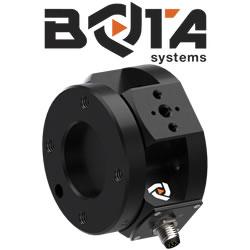We have created electronic circuitry that is soft and stretchable and capable of spontaneously reforming electrical connections when the material is cut, torn, or punctured. It is made of microscopic droplets of liquid metal that are suspended in a soft silicone rubber.
Self-healing Circuits
Carmel Majidi | Soft Machines Laboratory
Your lab develops cutting-edge technologies in the field of soft matter engineering, from liquid and invisible circuits to thermally conductive elastomers. Tell us about your latest breakthrough with self-healing circuits.
We have created electronic circuitry that is soft and stretchable and capable of spontaneously reforming electrical connections when the material is cut, torn, or punctured. The fact that it’s elastically deformable and as soft as natural skin means that it could be used for wearable computing or soft humanoid robots that are safe for physical interaction. Other repairable electronics are either mechanically rigid (like conventional electronics) or require manual intervention in order to repair broken connections.
How does it work? How does the material “know” what to do spontaneously?
The material is made of microscopic droplets of liquid metal that are suspended in a soft silicone rubber. We create circuits by pressing a pen against the material to cause the droplets to rupture and form connected, electrically conductive pathways within the rubber. When the circuit line is damaged, the stresses from the damaging load will cause the surrounding droplets to rupture and form new conductive pathways that automatically restore the circuit network. The material properties of the rubber and the size and concentration of the liquid metal droplets are carefully selected so that the conductive pathways spontaneously form under the same pressures that arise when the material is damaged.
What kinds of industries will benefit from self-healing materials? Can you give us examples of uses of this technology? (Talk about data and power transmission—“the future will still have wires”—as well as soft robotics and assistant robots. Inflatable structures, etc.)
.jpg)
Immediate commercial applications include smart textiles that could be used for incorporating electrical wiring into clothing, blankets, or inflatable structures. As with conventional textiles, the material must remain functional as it undergoes mechanical damage. Examples include electrical wiring incorporated into the walls of in deployable structures that are used as temporary shelters. As in conventional buildings, the wiring can be used to power electrical fixtures or be used for data transmission.
Scientifically, the material has many potentially interesting uses in bio-inspired soft robotics, wearable computing, and human-machine interaction. Because of its combination of elasticity, electronic functionality, and self-healing properties, it can function like an “artificial nervous tissue” for transmitting signals and stimuli.
What will it take to bring this technology to the marketplace and how does that typically come about with a breakthrough of this type?
The materials can be easily mass-produced using existing material manufacturing techniques (e.g. liquid shear mixing) and so we don’t anticipate any barriers with scaling up production. The main challenge will be to find existing applications that already use electrically conductive materials that are soft and elastic and to demonstrate how these products can be improved if they are more damage-resistant. We would love to hear from material suppliers and manufacturers to learn more about how they use soft conductive materials and what practical challenges they face.
We’re getting closer and closer to having soft, humanoid robots interacting with us. What would you say to those who are worried about this? How can having such robots improve our quality of life? (assistance getting into wheel chair, first responder robots, etc.)
Machines and robots that are made up of soft, squishy materials will be more safe and comfortable for physical interaction. They could work in close proximity to humans and provide assistance in strenuous physical tasks. Soft mobile robots could also be used for exploration and to perform search-and-rescue operations in environments that are challenging for more rigid machines or wheeled vehicles.
Of course, as robots continue to become more life-like, there’s the natural concern that they could replace human labor or companionship. These are legitimate concerns, but ones that are not unique to soft, humanoid robots. Most technologies, whether or not they’re anthropomorphic, have the potential to replace certain human roles. However, in doing so they can also make humans more productive or broaden their opportunities to have richer experiences.
To develop your healable circuits, you used an off-the-shelf device, the Cricut, that is commonly used as a crafting tool. How did this come about?
We were looking for a simple tool to trace circuits into the material. We were originally thinking of using a pen-plotter, but then came across the Cricut which was better suited for this application since it could apply higher pressure to the material.
Look into your crystal ball and tell us how you see robotics influencing our world 10 years from now?
Robotics will continue to have significant impact on enhancing mobility. While much of the research focus today is on driverless vehicles, I expect increasing focus on enhanced human mobility through soft wearable technologies. Wearables will also continue to have an increasing role in personal computing and VR/AR. For these applications, it will be important to have stretchable electronics that are resilient and able to handle the wear-and-tear of everyday use.
Are there other related projects that you would like to discuss here or in a future interview?
In the future, I’d love to talk about our efforts in wireless/untethered soft robots. My lab recently had a review paper on this topic in the journal Nature Electronics and we hope to publish a paper soon on our latest accomplishments within this field.

About Dr. Majidi
Dr. Majidi is an Associate Professor of Mechanical Engineering at Carnegie Mellon University where he runs the Integrated Soft Machines Laboratory. His research group uses insights and practices in solid mechanics, microfabrication, and rapid prototyping to engineer new classes of soft multifunctional materials for applications in wearable computing and robotics.
The content & opinions in this article are the author’s and do not necessarily represent the views of RoboticsTomorrow
Comments (0)
This post does not have any comments. Be the first to leave a comment below.
Featured Product

